Yuning Du
PP-DocLayout: A Unified Document Layout Detection Model to Accelerate Large-Scale Data Construction
Mar 21, 2025Abstract:Document layout analysis is a critical preprocessing step in document intelligence, enabling the detection and localization of structural elements such as titles, text blocks, tables, and formulas. Despite its importance, existing layout detection models face significant challenges in generalizing across diverse document types, handling complex layouts, and achieving real-time performance for large-scale data processing. To address these limitations, we present PP-DocLayout, which achieves high precision and efficiency in recognizing 23 types of layout regions across diverse document formats. To meet different needs, we offer three models of varying scales. PP-DocLayout-L is a high-precision model based on the RT-DETR-L detector, achieving 90.4% mAP@0.5 and an end-to-end inference time of 13.4 ms per page on a T4 GPU. PP-DocLayout-M is a balanced model, offering 75.2% mAP@0.5 with an inference time of 12.7 ms per page on a T4 GPU. PP-DocLayout-S is a high-efficiency model designed for resource-constrained environments and real-time applications, with an inference time of 8.1 ms per page on a T4 GPU and 14.5 ms on a CPU. This work not only advances the state of the art in document layout analysis but also provides a robust solution for constructing high-quality training data, enabling advancements in document intelligence and multimodal AI systems. Code and models are available at https://github.com/PaddlePaddle/PaddleX .
The MRI Scanner as a Diagnostic: Image-less Active Sampling
Jun 24, 2024Abstract:Despite the high diagnostic accuracy of Magnetic Resonance Imaging (MRI), using MRI as a Point-of-Care (POC) disease identification tool poses significant accessibility challenges due to the use of high magnetic field strength and lengthy acquisition times. We ask a simple question: Can we dynamically optimise acquired samples, at the patient level, according to an (automated) downstream decision task, while discounting image reconstruction? We propose an ML-based framework that learns an active sampling strategy, via reinforcement learning, at a patient-level to directly infer disease from undersampled k-space. We validate our approach by inferring Meniscus Tear in undersampled knee MRI data, where we achieve diagnostic performance comparable with ML-based diagnosis, using fully sampled k-space data. We analyse task-specific sampling policies, showcasing the adaptability of our active sampling approach. The introduced frugal sampling strategies have the potential to reduce high field strength requirements that in turn strengthen the viability of MRI-based POC disease identification and associated preliminary screening tools.
The state-of-the-art in Cardiac MRI Reconstruction: Results of the CMRxRecon Challenge in MICCAI 2023
Apr 01, 2024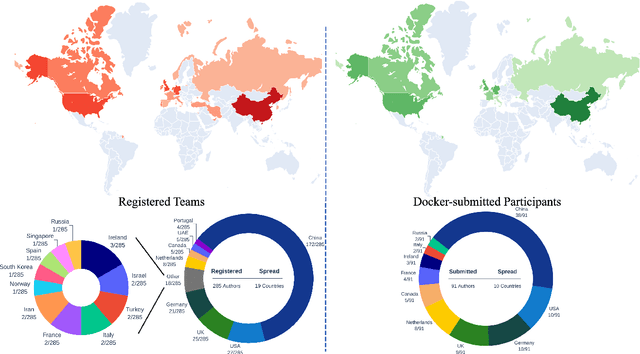
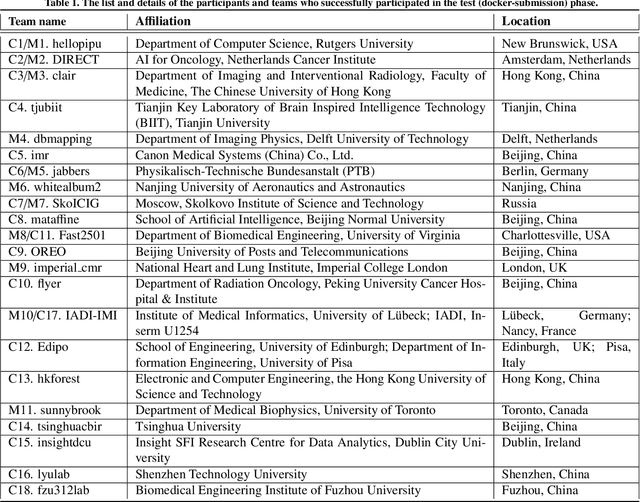
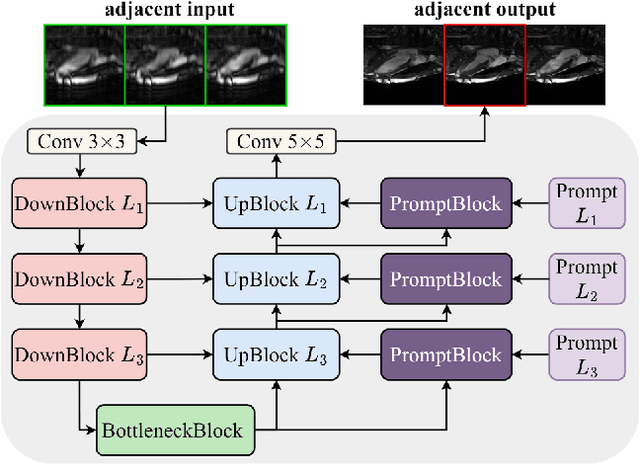
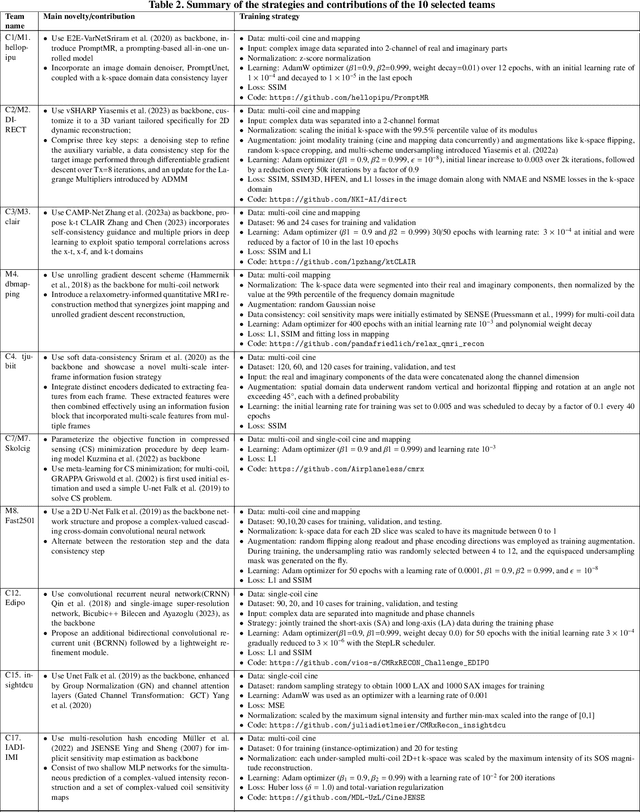
Abstract:Cardiac MRI, crucial for evaluating heart structure and function, faces limitations like slow imaging and motion artifacts. Undersampling reconstruction, especially data-driven algorithms, has emerged as a promising solution to accelerate scans and enhance imaging performance using highly under-sampled data. Nevertheless, the scarcity of publicly available cardiac k-space datasets and evaluation platform hinder the development of data-driven reconstruction algorithms. To address this issue, we organized the Cardiac MRI Reconstruction Challenge (CMRxRecon) in 2023, in collaboration with the 26th International Conference on MICCAI. CMRxRecon presented an extensive k-space dataset comprising cine and mapping raw data, accompanied by detailed annotations of cardiac anatomical structures. With overwhelming participation, the challenge attracted more than 285 teams and over 600 participants. Among them, 22 teams successfully submitted Docker containers for the testing phase, with 7 teams submitted for both cine and mapping tasks. All teams use deep learning based approaches, indicating that deep learning has predominately become a promising solution for the problem. The first-place winner of both tasks utilizes the E2E-VarNet architecture as backbones. In contrast, U-Net is still the most popular backbone for both multi-coil and single-coil reconstructions. This paper provides a comprehensive overview of the challenge design, presents a summary of the submitted results, reviews the employed methods, and offers an in-depth discussion that aims to inspire future advancements in cardiac MRI reconstruction models. The summary emphasizes the effective strategies observed in Cardiac MRI reconstruction, including backbone architecture, loss function, pre-processing techniques, physical modeling, and model complexity, thereby providing valuable insights for further developments in this field.
Unveiling Fairness Biases in Deep Learning-Based Brain MRI Reconstruction
Sep 25, 2023Abstract:Deep learning (DL) reconstruction particularly of MRI has led to improvements in image fidelity and reduction of acquisition time. In neuroimaging, DL methods can reconstruct high-quality images from undersampled data. However, it is essential to consider fairness in DL algorithms, particularly in terms of demographic characteristics. This study presents the first fairness analysis in a DL-based brain MRI reconstruction model. The model utilises the U-Net architecture for image reconstruction and explores the presence and sources of unfairness by implementing baseline Empirical Risk Minimisation (ERM) and rebalancing strategies. Model performance is evaluated using image reconstruction metrics. Our findings reveal statistically significant performance biases between the gender and age subgroups. Surprisingly, data imbalance and training discrimination are not the main sources of bias. This analysis provides insights of fairness in DL-based image reconstruction and aims to improve equity in medical AI applications.
Cine cardiac MRI reconstruction using a convolutional recurrent network with refinement
Sep 23, 2023Abstract:Cine Magnetic Resonance Imaging (MRI) allows for understanding of the heart's function and condition in a non-invasive manner. Undersampling of the $k$-space is employed to reduce the scan duration, thus increasing patient comfort and reducing the risk of motion artefacts, at the cost of reduced image quality. In this challenge paper, we investigate the use of a convolutional recurrent neural network (CRNN) architecture to exploit temporal correlations in supervised cine cardiac MRI reconstruction. This is combined with a single-image super-resolution refinement module to improve single coil reconstruction by 4.4\% in structural similarity and 3.9\% in normalised mean square error compared to a plain CRNN implementation. We deploy a high-pass filter to our $\ell_1$ loss to allow greater emphasis on high-frequency details which are missing in the original data. The proposed model demonstrates considerable enhancements compared to the baseline case and holds promising potential for further improving cardiac MRI reconstruction.
Context Perception Parallel Decoder for Scene Text Recognition
Jul 23, 2023



Abstract:Scene text recognition (STR) methods have struggled to attain high accuracy and fast inference speed. Autoregressive (AR)-based STR model uses the previously recognized characters to decode the next character iteratively. It shows superiority in terms of accuracy. However, the inference speed is slow also due to this iteration. Alternatively, parallel decoding (PD)-based STR model infers all the characters in a single decoding pass. It has advantages in terms of inference speed but worse accuracy, as it is difficult to build a robust recognition context in such a pass. In this paper, we first present an empirical study of AR decoding in STR. In addition to constructing a new AR model with the top accuracy, we find out that the success of AR decoder lies also in providing guidance on visual context perception rather than language modeling as claimed in existing studies. As a consequence, we propose Context Perception Parallel Decoder (CPPD) to decode the character sequence in a single PD pass. CPPD devises a character counting module and a character ordering module. Given a text instance, the former infers the occurrence count of each character, while the latter deduces the character reading order and placeholders. Together with the character prediction task, they construct a context that robustly tells what the character sequence is and where the characters appear, well mimicking the context conveyed by AR decoding. Experiments on both English and Chinese benchmarks demonstrate that CPPD models achieve highly competitive accuracy. Moreover, they run approximately 7x faster than their AR counterparts, and are also among the fastest recognizers. The code will be released soon.
ICDAR 2023 Competition on Structured Text Extraction from Visually-Rich Document Images
Jun 05, 2023Abstract:Structured text extraction is one of the most valuable and challenging application directions in the field of Document AI. However, the scenarios of past benchmarks are limited, and the corresponding evaluation protocols usually focus on the submodules of the structured text extraction scheme. In order to eliminate these problems, we organized the ICDAR 2023 competition on Structured text extraction from Visually-Rich Document images (SVRD). We set up two tracks for SVRD including Track 1: HUST-CELL and Track 2: Baidu-FEST, where HUST-CELL aims to evaluate the end-to-end performance of Complex Entity Linking and Labeling, and Baidu-FEST focuses on evaluating the performance and generalization of Zero-shot / Few-shot Structured Text extraction from an end-to-end perspective. Compared to the current document benchmarks, our two tracks of competition benchmark enriches the scenarios greatly and contains more than 50 types of visually-rich document images (mainly from the actual enterprise applications). The competition opened on 30th December, 2022 and closed on 24th March, 2023. There are 35 participants and 91 valid submissions received for Track 1, and 15 participants and 26 valid submissions received for Track 2. In this report we will presents the motivation, competition datasets, task definition, evaluation protocol, and submission summaries. According to the performance of the submissions, we believe there is still a large gap on the expected information extraction performance for complex and zero-shot scenarios. It is hoped that this competition will attract many researchers in the field of CV and NLP, and bring some new thoughts to the field of Document AI.
DETRs Beat YOLOs on Real-time Object Detection
Apr 17, 2023



Abstract:Recently, end-to-end transformer-based detectors (DETRs) have achieved remarkable performance. However, the issue of the high computational cost of DETRs has not been effectively addressed, limiting their practical application and preventing them from fully exploiting the benefits of no post-processing, such as non-maximum suppression (NMS). In this paper, we first analyze the influence of NMS in modern real-time object detectors on inference speed, and establish an end-to-end speed benchmark. To avoid the inference delay caused by NMS, we propose a Real-Time DEtection TRansformer (RT-DETR), the first real-time end-to-end object detector to our best knowledge. Specifically, we design an efficient hybrid encoder to efficiently process multi-scale features by decoupling the intra-scale interaction and cross-scale fusion, and propose IoU-aware query selection to improve the initialization of object queries. In addition, our proposed detector supports flexibly adjustment of the inference speed by using different decoder layers without the need for retraining, which facilitates the practical application of real-time object detectors. Our RT-DETR-L achieves 53.0% AP on COCO val2017 and 114 FPS on T4 GPU, while RT-DETR-X achieves 54.8% AP and 74 FPS, outperforming all YOLO detectors of the same scale in both speed and accuracy. Furthermore, our RT-DETR-R50 achieves 53.1% AP and 108 FPS, outperforming DINO-Deformable-DETR-R50 by 2.2% AP in accuracy and by about 21 times in FPS. Source code and pretrained models will be available at PaddleDetection.
PP-StructureV2: A Stronger Document Analysis System
Oct 11, 2022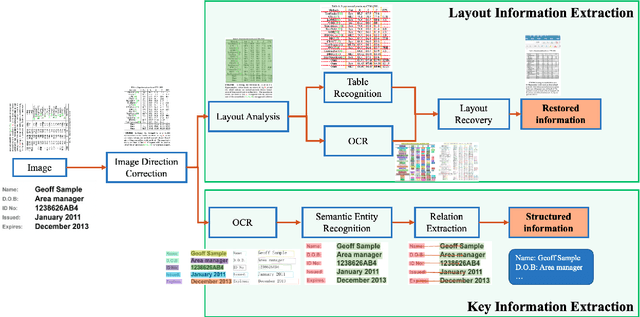

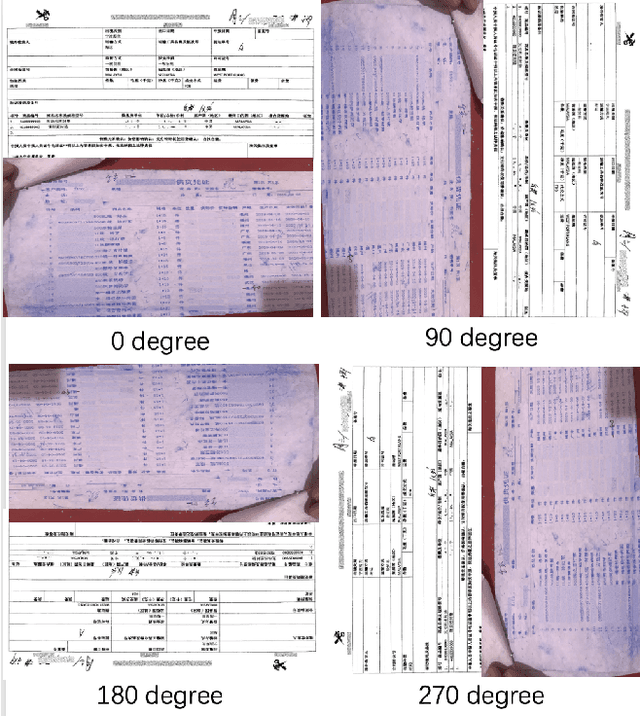

Abstract:A large amount of document data exists in unstructured form such as raw images without any text information. Designing a practical document image analysis system is a meaningful but challenging task. In previous work, we proposed an intelligent document analysis system PP-Structure. In order to further upgrade the function and performance of PP-Structure, we propose PP-StructureV2 in this work, which contains two subsystems: Layout Information Extraction and Key Information Extraction. Firstly, we integrate Image Direction Correction module and Layout Restoration module to enhance the functionality of the system. Secondly, 8 practical strategies are utilized in PP-StructureV2 for better performance. For Layout Analysis model, we introduce ultra light-weight detector PP-PicoDet and knowledge distillation algorithm FGD for model lightweighting, which increased the inference speed by 11 times with comparable mAP. For Table Recognition model, we utilize PP-LCNet, CSP-PAN and SLAHead to optimize the backbone module, feature fusion module and decoding module, respectively, which improved the table structure accuracy by 6\% with comparable inference speed. For Key Information Extraction model, we introduce VI-LayoutXLM which is a visual-feature independent LayoutXLM architecture, TB-YX sorting algorithm and U-DML knowledge distillation algorithm, which brought 2.8\% and 9.1\% improvement respectively on the Hmean of Semantic Entity Recognition and Relation Extraction tasks. All the above mentioned models and code are open-sourced in the GitHub repository PaddleOCR.
PP-OCRv3: More Attempts for the Improvement of Ultra Lightweight OCR System
Jun 07, 2022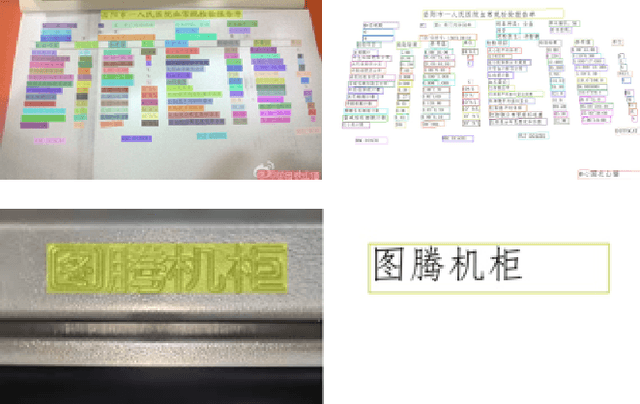

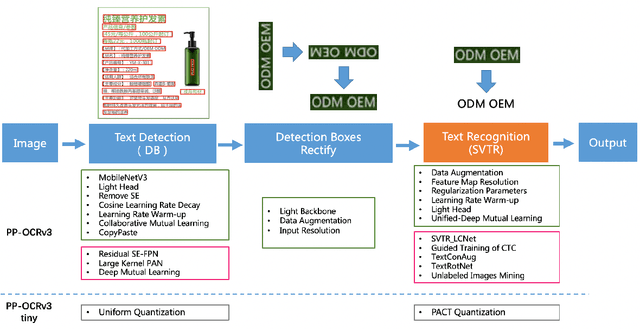

Abstract:Optical character recognition (OCR) technology has been widely used in various scenes, as shown in Figure 1. Designing a practical OCR system is still a meaningful but challenging task. In previous work, considering the efficiency and accuracy, we proposed a practical ultra lightweight OCR system (PP-OCR), and an optimized version PP-OCRv2. In order to further improve the performance of PP-OCRv2, a more robust OCR system PP-OCRv3 is proposed in this paper. PP-OCRv3 upgrades the text detection model and text recognition model in 9 aspects based on PP-OCRv2. For text detector, we introduce a PAN module with large receptive field named LK-PAN, a FPN module with residual attention mechanism named RSE-FPN, and DML distillation strategy. For text recognizer, the base model is replaced from CRNN to SVTR, and we introduce lightweight text recognition network SVTR LCNet, guided training of CTC by attention, data augmentation strategy TextConAug, better pre-trained model by self-supervised TextRotNet, UDML, and UIM to accelerate the model and improve the effect. Experiments on real data show that the hmean of PP-OCRv3 is 5% higher than PP-OCRv2 under comparable inference speed. All the above mentioned models are open-sourced and the code is available in the GitHub repository PaddleOCR which is powered by PaddlePaddle.
 Add to Chrome
Add to Chrome Add to Firefox
Add to Firefox Add to Edge
Add to Edge